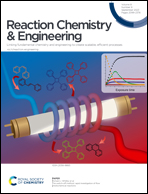Metal–organic framework-supported ionic liquids for lipase immobilization: design, characterization, and investigation of catalytic performance†
Abstract
Recently, ionic liquids (ILs) have shown potential in enzyme activation and stabilization. In this work, ILs consisting of imidazolium-based cations coupled with [Tf2N]− anions were grafted onto a magnetic Ca2+-based metal–organic framework (CaBDC), and the composites were then employed to immobilize lipase. The support of ILs/MCaBDC and immobilized porcine pancreatic lipase (PPL) of PPL-ILs/MCaBDC were thoroughly characterized and fully investigated. Compared with a wild enzyme, PPL-ILs/MCaBDC showed 2.16 times higher activity. After introducing the ILs into the supports, PPL-ILs/MCaBDC showed enhanced thermal, storage, and stability properties compared with PPL–MCaBDC. After 10 cycles, PPL-ILs/MCaBDC retained a higher (83.2%) fraction of its initial activity than PPL–MCaBDC (73.4%). Furthermore, the relationship between the support–enzyme interactions and the structural changes of immobilized lipase was also analyzed in detail. Application of circular dichroism (CD) spectroscopy analysis helped us understand the changes of the enzyme secondary structure. Therefore, this work further confirmed the effectiveness of ILs for enzyme immobilization.



 Please wait while we load your content...
Please wait while we load your content...